Berry smoothies boost your cellular healing by delivering powerful antioxidants like anthocyanins and polyphenols that neutralize harmful free radicals and reduce inflammation. When you blend berries, you’re increasing nutrient bioavailability, allowing your cells to absorb these protective compounds more efficiently. These nutrients activate your body’s natural defense systems, trigger repair pathways, and provide essential vitamins and minerals that support DNA protection and tissue regeneration. Discover how this nutritional powerhouse transforms your health at the molecular level.
The Science Behind Antioxidants and Cellular Protection
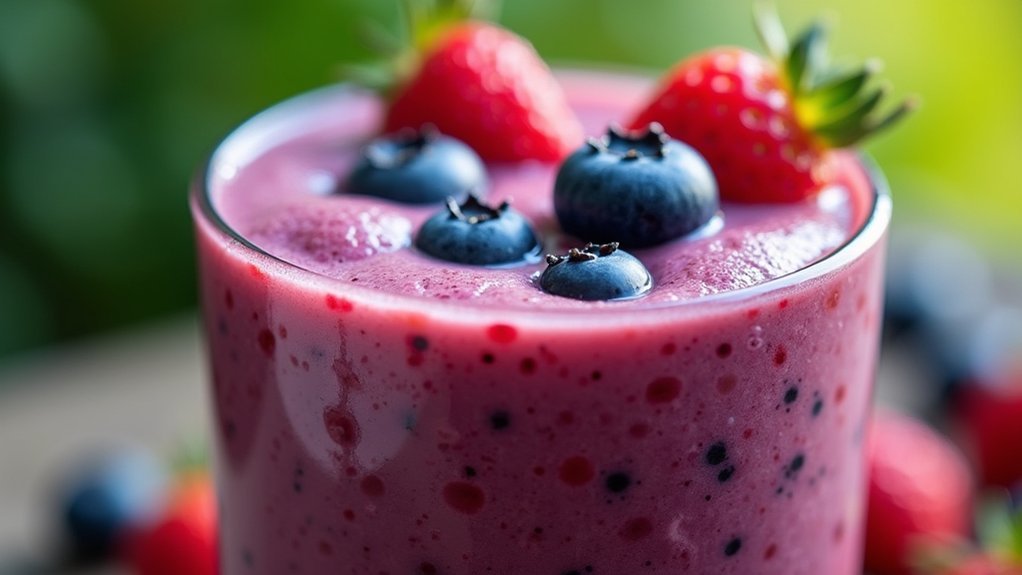
When you sip a berry smoothie, you’re delivering powerful phytochemicals that actively combat cellular damage at the molecular level.
These compounds don’t just neutralize harmful reactive oxygen species—they’re actively enhancing your body’s natural defense systems.
Your cells respond by upregulating essential antioxidant enzymes like superoxide dismutase and catalase.
Berry metabolites trigger Nrf-2 pathways, which stimulate production of protective enzymes including heme oxygenase-1.
This cascade effect means you’re not just getting temporary protection—you’re boosting your cellular resilience long-term.
The anthocyanins and polyphenols in berries also strengthen cell membranes against lipid peroxidation while maintaining ideal redox balance.
This thorough protection shields your DNA from oxidative damage, supporting your body’s natural healing processes. Research shows that black currant extract specifically demonstrated antioxidant effects comparable to pharmaceutical-grade antioxidants in protecting heart muscle cells.
How Anti-Inflammatory Compounds in Berries Support Healing
Beyond their antioxidant prowess, berries pack a secondary punch against inflammation—your body’s overactive immune response that can hinder healing. When you consume berries, their polyphenols target key inflammatory pathways like NF-κB and TLR4 signaling, effectively dialing down your body’s inflammatory response. This targeted action creates an ideal environment for cellular repair.
| Inflammatory Pathway | Berry Mechanism | Healing Benefit |
|---|---|---|
| NF-κB Signaling | Inhibits activation | Reduces chronic inflammation |
| TLR4 Signaling | Down-regulates response | Modulates immune activity |
| Cytokine Production | Controls inflammatory markers | Supports tissue repair |
Different berries offer unique anti-inflammatory profiles. Blueberries’ anthocyanins excel at cardiovascular protection, while strawberries’ ellagic acid supports broader healing processes. Native Chilean berries like murta demonstrate that triterpenoid acids in their leaves contribute significantly to anti-inflammatory effects. This multi-targeted approach means you’re not just fighting inflammation—you’re actively promoting your body’s natural healing mechanisms.
Key Nutrients That Drive Cellular Repair Mechanisms
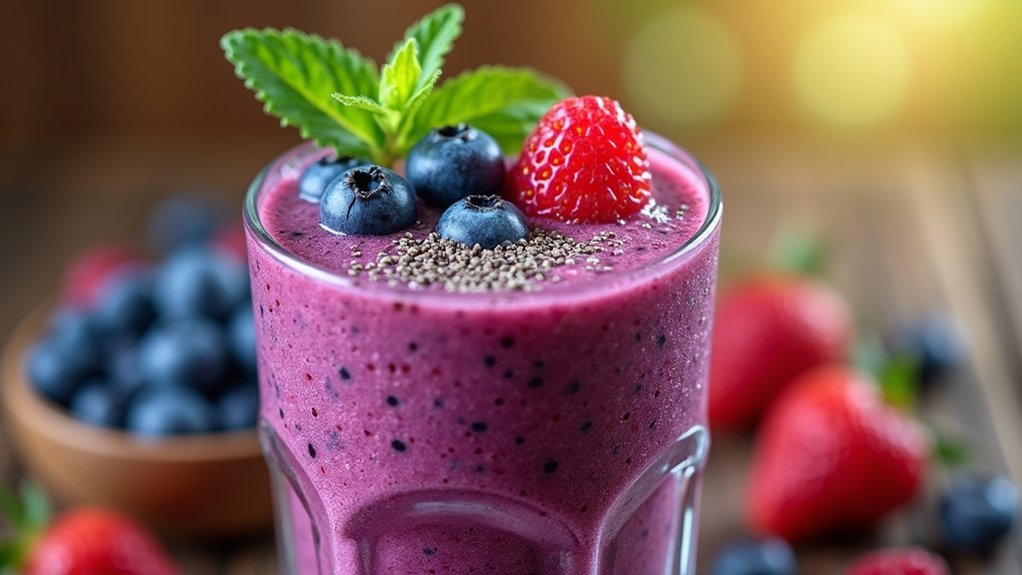
While inflammation control sets the stage for healing, specific nutrients within berry smoothies actively fuel your body’s repair machinery at the cellular level.
Vitamin C and E counteract oxidative damage while protecting your mitochondrial DNA from stress. These antioxidants create an essential environment for DNA repair enzymes to function effectively.
Omega-3 fatty acids enhance your stem cell viability and promote membrane fluidity necessary for tissue regeneration. They regulate genes controlling cell proliferation and differentiation, supporting natural healing processes.
B vitamins, vitamin D, zinc, and magnesium serve as vital cofactors for repair enzymes. Zinc drives collagen synthesis, while magnesium powers ATP production for energy-dependent repair pathways.
Berry nutrients also promote mitophagy, removing defective mitochondria and stimulating biogenesis for enhanced cellular energy production. Wild blueberries provide particularly concentrated antioxidant protection that supports mitochondrial function and combats age-related cellular decline.
The Role of Polyphenols in Fighting Oxidative Stress
As your cells face constant bombardment from free radicals and environmental toxins, polyphenols in berry smoothies act as your body’s molecular guardians, intercepting these damaging compounds before they can wreak havoc on your DNA, proteins, and cellular membranes.
These powerful compounds don’t just neutralize existing damage—they boost your cellular defense systems by activating Nrf2 pathways and upregulating antioxidant enzymes like superoxide dismutase. The complex biological interactions of polyphenols involve intricate cellular signaling cascades that extend far beyond simple antioxidant activity.
When you consume polyphenol-rich berries, you’re triggering three critical protective mechanisms:
- Direct scavenging of reactive oxygen species before they damage cellular components
- Enhanced production of your body’s natural antioxidant enzymes and glutathione
- Suppression of inflammatory pathways including NF-κB and pro-oxidant enzyme activity
This creates a thorough shield against oxidative stress.
Berry Smoothies vs. Whole Berries: Enhanced Nutrient Absorption
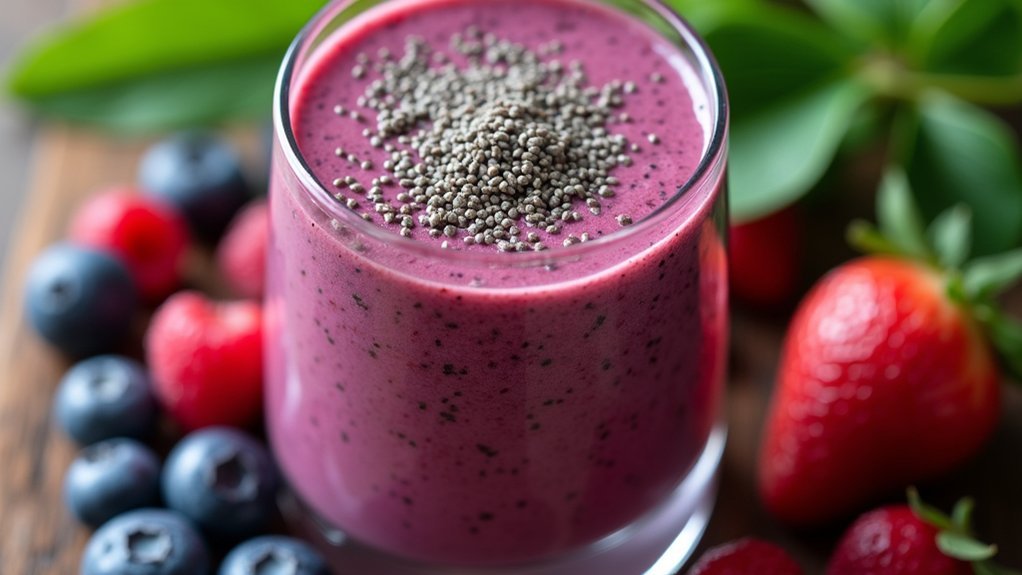
Understanding how polyphenols protect your cells reveals only part of the story—the method you use to consume these powerful berries greatly impacts how well your body can actually absorb and utilize their healing compounds.
When you blend berries into smoothies, you’re breaking down cell walls and increasing nutrient surface area, which enhances bioavailability and makes vitamins and antioxidants easier for your body to absorb.
However, this mechanical action also disrupts fiber structure, leading to faster sugar absorption compared to whole berries. Whole berries retain their intact fiber, which slows sugar absorption and provides steadier energy release.
While blending increases certain nutrient absorption, it can reduce flavanol levels and cause some nutrient loss during processing, creating a trade-off you’ll need to evaluate. Research shows that certain ingredient combinations can enhance nutritional benefits when preparing smoothies.
Research-Backed Evidence on Berry Consumption and Health Outcomes
You’ll find compelling scientific evidence supporting berry consumption’s impact on your metabolic health, with studies showing significant improvements in metabolic syndrome markers among regular consumers.
Research consistently demonstrates that your cognitive function benefits from berry intake, particularly as you age, with measurable improvements in memory and processing speed.
Studies also reveal that berry consumption enhances blood flow to your brain, supporting better neural communication and potentially protecting against cognitive decline. Current research methodologies are advancing our understanding of how specific berry compounds interact with cellular repair mechanisms at the molecular level.
Metabolic Syndrome Improvements
When you consume berry smoothies regularly, you’re delivering powerful polyphenols like anthocyanins and phenolic acids directly to your cells, where they combat oxidative stress and inflammation—two primary drivers of metabolic syndrome.
These potent compounds work systematically to address multiple metabolic dysfunction markers. The antioxidants scavenge free radicals that damage cellular repair mechanisms, while anti-inflammatory properties reduce pro-inflammatory cytokines like IL-6 and TNF-α. This dual action supports improved insulin sensitivity and glucose tolerance. Regular berry consumption creates a pro-thrombotic environment that helps prevent dangerous blood clot formation associated with metabolic complications.
Berry smoothies particularly benefit metabolic syndrome through:
- Lipid profile improvements – Increasing HDL cholesterol while decreasing LDL cholesterol and triglycerides, reducing atherosclerosis risk
- Enhanced glucose metabolism – Supporting pancreatic beta-cell function and cellular glucose uptake pathways
- Blood pressure regulation – Improving endothelial function and nitric oxide bioavailability for healthier vascular tone
Cognitive Function Studies
Recent breakthroughs in neuroscience research reveal that berry smoothies don’t just satisfy your taste buds—they’re actively rewiring your brain for better performance.
Clinical trials show that you’ll experience improved attention, memory, and executive functions when you consume berries regularly. Your processing speed and reaction times get faster, while working memory capacity increases considerably.
The flavonoids in your berry smoothie enhance neuronal connections and reduce harmful neuroinflammation that causes cognitive decline. You’re also boosting brain blood flow, delivering more oxygen and nutrients to neural tissue.
Functional MRI studies demonstrate increased brain activity in cognition-related regions after berry consumption.
Most importantly, you’re building resilience against age-related memory loss and neurodegenerative diseases while supporting your brain’s natural repair mechanisms. Research indicates that higher polyphenol doses of approximately 500 mg daily may be particularly effective in preventing cognitive decline.
Brain Perfusion Benefits
While your berry smoothie delights your taste buds, it’s simultaneously orchestrating a remarkable transformation in your brain’s blood circulation patterns. The flavonoids in berries enhance blood flow to critical brain regions, creating measurable improvements in neural function.
Research demonstrates that blueberry consumption specifically increases activity in areas responsible for cognitive processing, memory formation, and sensory integration. Studies show participants consuming strawberries and blueberries demonstrated superior memory performance compared to placebo groups.
Your brain experiences these perfusion benefits through three key mechanisms:
- Enhanced vascular function – Antioxidants strengthen blood vessel walls and improve circulation efficiency throughout your brain tissue.
- Reduced neuroinflammation – Anti-inflammatory compounds decrease swelling that restricts blood flow to neurons.
- Increased grey matter perfusion – Studies show improved blood flow specifically to parietal and occipital lobes, boosting cognitive performance.
This enhanced circulation delivers oxygen and nutrients more effectively to your brain cells.
Frequently Asked Questions
How Many Berry Smoothies Should I Drink Daily for Optimal Healing Benefits?
You should aim for one berry smoothie daily as part of your total fruit intake. There’s no specific research defining ideal smoothie quantities, but experts recommend several berry servings weekly for cellular healing benefits.
Can Frozen Berries Provide the Same Cellular Healing Properties as Fresh Ones?
You’ll get nearly identical cellular healing benefits from frozen berries since they’re picked at peak ripeness and retain their antioxidants, vitamins, and anti-inflammatory compounds just as effectively as fresh ones.
What Time of Day Is Best to Consume Berry Smoothies for Healing?
You’ll maximize healing benefits by drinking berry smoothies in the morning to kickstart metabolism, post-workout for anti-inflammatory recovery, or consistently throughout the day since regular consumption enhances cellular repair over time.
Do Certain Berry Combinations Work Better Together for Cellular Repair Than Others?
You’ll find that combining different berries creates synergistic effects where mixed anthocyanins and phenolic compounds enhance cellular repair more effectively than single berry extracts alone through diverse bioactive pathways.
How Long Does It Take to See Cellular Healing Effects From Drinking Berry Smoothies?
You’ll notice improved nutrient absorption and reduced oxidative stress within days of drinking berry smoothies. Skin health and inflammation improvements typically appear within weeks, while cardiovascular benefits develop over several months.
In Summary
You’ve learned how berry smoothies deliver concentrated antioxidants, polyphenols, and anti-inflammatory compounds that combat oxidative stress and accelerate cellular repair. The blending process breaks down cell walls, making these healing nutrients more bioavailable than whole berries alone. Research consistently shows that regular berry consumption reduces inflammation markers and supports your body’s natural healing mechanisms. By incorporating nutrient-dense berry smoothies into your routine, you’re providing your cells with essential tools for ideal recovery and regeneration.

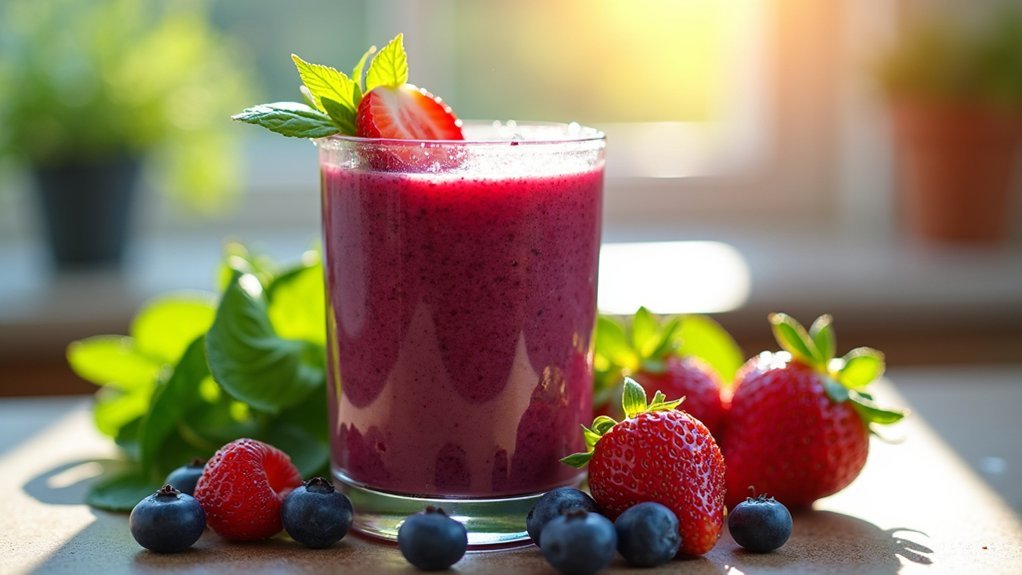
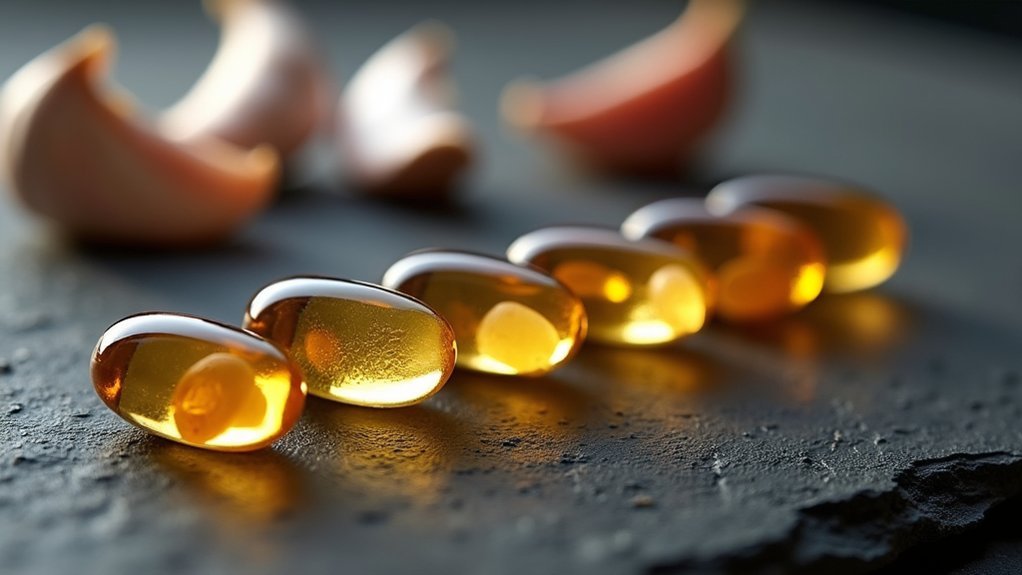


Leave a Reply